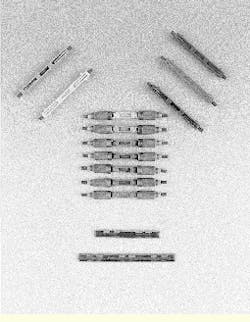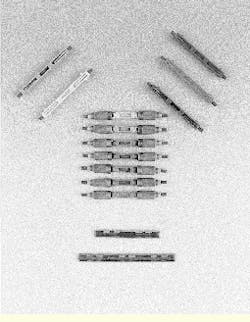Arlyn S. Powell, Jr.
When it comes to joining two optical fibers, conventional wisdom says that there are two ways to do it, and only one of those ways is lasting. However, as is often the case with conventional wisdom, modern technology appears to have left it behind.
The two methods are fusion and mechanical splicing. Fusion splicing uses an electric arc to melt the ends of the glass fibers and fuse them together. This method is reputed to produce a mechanically stronger splice that outperforms the mechanical splice in terms of transmission loss. For these two reasons, mechanical splices, which function by holding the two fiber endfaces together in some sort of sleeve, have come to be looked upon as temporary measures to be used until fusion splicing can replace them.
But why not just fusion splice the fibers in the first place, and skip the mechanical splice altogether? It`s in answering this question that things begin to get complicated. Mechanical splices are inexpensive and easy to use compared to fusion splicing. A fusion splicer is a sophisticated device that costs in the range of $50,000 and requires significant training to use. Hence, the conventional wisdom: When a backhoe cuts an optical fiber, send out an emergency crew to apply a mechanical splice and come back later with a fusion splicer to permanently repair the damage.
The reality, however, is that often the follow-up fusion splice never gets made--and more and more people in the cabling industry are arguing that it doesn`t need to be made. For example, Jim Hayes, president of Fotec Inc. (Boston, MA), a fiber-optic test equipment manufacturer, and founder of The Fiber Optic Association, knows the conventional wisdom as well as anyone, but, he says, "We don`t recommend fusion splicing at all anymore for multimode fiber."
Quipping that those who don`t study history are doomed to repeat it, Hayes points out that telephone companies long ago tried and gave up on multimode fiber for their transmission networks, switching instead to singlemode. "And the reason was simple," Hayes adds. "Multimode fiber is step-indexed, meaning that the index of refraction of the glass varies across the hundreds of layers deposited in the fiber-making process. When you fusion-splice step-indexed multimode fiber, the layers melt together and the benefits of step-indexing are lost. You get a loss point where the mode power distribution of the light gets confused."
Second-generation mechanical splices
Other industry experts are a bit less radical than Hayes, admitting the continued superiority of fusion splicing but adding quickly that mechanical splices have come a long way recently in addressing the durability and performance issues that have plagued them in the past. Larry Johnson, president of The Light Brigade (Kent, WA), a fiber-optic manufacturing, installation and training company, observes that mechanical splices are in their second generation now, following a major shakeout of manufacturers in this area. "The older generation," Johnson says, "were expensive in terms of the splices themselves, the tooling needed to install them and the time it took." Costing about $20 each, these splices might require a special tool costing $100 or more to close or crimp them. Some used epoxy which had to be cured with ultraviolet light.
The second generation of mechanical splices cost about $10 each and depend on gripping technology rather than epoxy curing. "They also don`t require tuning," Johnson adds. "You can perform blind splices for restoration work." (Tuning is a process where one of the fibers in the splice is rotated until transmission loss is minimized. Only then is the splice locked into place.)
Johnson also cautions that manufacturers who claim their products can match fusion splices in performance are speaking about transmission loss through the splice only, and not about backreflection. Reflection of the signal from the fiber endface is still a performance issue with mechanical splices unless the fibers are cleaved at an angle.
Major players
The new generation of mechanical splices has been ushered in by a consolidation in the marketplace. Siecor Corp. (Hickory, NC) bought out the mechanical-splice lines of both GTE Fiber-optic Products (Williamsport, PA) and Northern Telecom (St. Laurent, Quebec). As of 1994, the major players in the market were 3M Private Network Products (Austin, TX), with half the annual sales of $13.5 million in the U.S., followed by AT&T Network Cable Systems (Morristown, NJ) with 23%, Siecor with 19% and AMP Inc. (Harrisburg, PA) with 5%.
"Telecommunications is the dominant application," says J. Stephen Montgomery, vice president of marketing for Electronicast Corp. (San Mateo, CA), a market research firm that tracks the mechanical-splice market. Following the telephone companies, which accounted for 61% of global splice consumption in 1994, are premises data networks, with a 21% share. "By 2004," Montgomery continues, "the telecommunications share will drop to 52%, followed by premises data networks with 30%." Electronicast projects that the global market for mechanical splices will grow at 13% annually until 1999, and thereafter at 10% annually until 2004, at which time it will be valued at more than $101 million.
The mainstay of market leader 3M`s product line is the Fiberlok mechanical splice. Product-line manager Tom Richardson feels that Fiberlok`s success is due to its long-term reliability. "We have more than 5 million splices installed," he says, "and we`ve had them in the ground since the late 1980s without any problems."
Richardson claims that only the 3M Fiberlok and the AT&T rotary splice are used alongside fusion splicing for new construction. "About 20% of our sales are to the restoration side of the house at telephone companies," he says, "but we sell an awful lot more Fiberloks for new construction--to regional Bell operating companies, cable-TV companies, and, more and more, for premises data networks."
The Fiberlok splice`s reliability stems from V-groove technology. Once the two fiber ends are cleaned and cleaved, they are inserted into a V-shaped groove in a malleable aluminum part. A clamping tool is then used to push down a locking cap. Locking the cap in place forces the upper parts of the V legs together, holding the glass in place. "It gives us very good mechanical pull-out performance," Richardson states, "plus it keeps the fibers from pistoning with temperature changes." It takes about 30 seconds to complete the splice, once initial stripping and cleaving are done.
The Fiberlok is loaded with index-matching gel, and is actuated with a simple and inexpensive locking tool. It takes different buffer sizes, ranging from 250 to 900 microns, and is available both for single fibers and multifiber ribbon arrays. An installer can be trained to apply it in less than 30 minutes. 3M supports its splice line with a full range of splice trays and closures for both indoor and outdoor environments.
Performance and durability
The performance of 3M`s splice line is specified both in terms of insertion loss and reflection. "Our insertion loss is about 0.07 decibel, mean," Richardson states. "Our performance is about -60 dB at room temperature. If you use an angled cleave, you get about a 20-dB improvement above that."
With video transmission at temperature extremes, however, performance needs to be better than 55 dB. "When transmitting analog signals for cable TV," says Richardson, "we have a product called an angled-cleave adapter. It provides a 3- to 5-degree angle on the fiber endfaces. This gives you -60-dB performance across the entire temperature range, from -40 to +80 C. If you`re transmitting analog and going between buildings in a premises application, you`d want the angled cleave."
Richardson makes a final point about durability, claiming that mechanical splices may actually be superior to fusion splices in some instances. "On the fusion splices we`ve tested," he says, "you can have variable results when it comes to tensile strength. At the periphery of the splice, near where the arc actually fuses the fibers, the glass may be weakened. Of course, if you use a good sleeve, you`re going to get better results. But with our splice, you consistently get 3 pounds or more of pull-off strength."
All in all, about a dozen companies make fusion splices. Among the smaller manufacturers, Advanced Custom Applications (Belle Mead, NJ) is best known for introducing the first mechanical splice priced at under $10. According to marketing director Attila Huebscher, the company`s entire Ultrasplice product line, including items classified as specialty items until just last fall, is priced at $7.95 apiece.
The Ultrasplice centers around a glass capillary tube preloaded with index-matching gel. Once the fiber ends are cleaned and cleaved, they are inserted through ports at either end of the capillary tube until they meet in the middle. The use of glass for the capillary means the installer can visually observe fiber alignment while making and tuning the splice. Locking nuts at either end of the capillary tube clamp down on the fiber buffers. The locking nuts can be closed and opened repeatedly, making the splice both tunable and reusable. The locking nuts can also accommodate buffer sizes from 250 microns to one millimeter. Once cleaning and cleaving are done, it takes less than a minute to complete the splice.
"We made our product based on customer feedback," Huebscher says, "and what our customers said they wanted was something reusable and tunable. With other products out there, once you`ve snapped them together, you`ve had it. If you want to make any changes, you have to cut off the splice and redo it." The Ultrasplice can be tuned by assembling it and attaching a light-emitting diode or laser light source to one of the fibers. A red glow at the point of the splice indicates the need for tuning; one of the fibers can then be rotated until the glow disappears. When the fibers are properly aligned, the locking nuts are tightened and the splice is complete.
Huebscher also points out that ACA`s products require no special tools or fixtures. Aside from the extra cost, a special clamping tool like 3M`s may create other problems if lost, broken or simply left on the truck. "If the splice requires a key or a clamping tool," he adds, "you have to have that tool to close the product--no ifs, ands or buts about it. It`s best that the splice be self-sufficient, without having to use extra fixtures or jigs."
The average splice loss of the Ultrasplice is less than 0.2 dB, and the return loss is rated at -50 dB.
Besides having specialty sizes running up to 500 microns, ACA splices are available for both singlemode and multimode fibers, and can be used on plastic optical fibers as well. The Optosplice is an ultraviolet-cured product used in high-temperature environments.
Huebscher is optimistic about the future of mechanical splices. He particularly sees tremendous market potential in Third World countries that are just developing their telecommunications infrastructure.
The Light Brigade`s Johnson agrees. "It`s a healthy market," he says. "It will grow." In addition to the tripling of the international market for mechanical splices predicted by Electronicast, Johnson sees some other technical trends to watch. One is the continuing introduction of low-priced splices that are simple and quick to install. Another is the spread of angled-cleave technology to reduce backreflection in laser-based systems.
Still another idea is a bit more radical. Johnson asks, "Why not use a pigtail and a mechanical splice to replace a connector? It would be cheaper." He points out that preterminated pigtails are already widely used in singlemode applications.
Mechanical splicing products from Advanced Custom Applications (Belle Mead, NJ) include the Labsplice (top left) for testing and laboratory use, the Optosplice ultraviolet-curable mechanical splice (top right), the Ultrasleeve protection cover for fusion splices (bottom) and the Ultrasplice mechanical splice (center) for telecommunications, cable-TV and data networking applications.

